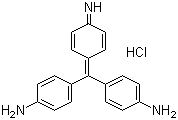-
Name
Basic Red 9
- EINECS 209-321-2
- CAS No. 569-61-9
- Article Data5
- CAS DataBase
- Density 0.999 g/mL at 20 °C
- Solubility 10 g/L (25 °C) in water
- Melting Point 250 °C
- Formula C19H17N3.HCl
- Boiling Point 568.2oC at 760mmHg
- Molecular Weight 396.747
- Flash Point 11 °C
- Transport Information UN 2924 3/PG 2
- Appearance green crystalline powder
- Safety 7-16-53-45-36/37
- Risk Codes 40-45-11
-
Molecular Structure
-
Hazard Symbols
 F,
F,  T,
T,  Xn
Xn
- Synonyms Benzenamine,4,4'-[(4-imino-2,5-cyclohexadien-1-ylidene)methylene]bis-, monohydrochloride(9CI);C.I. Basic Red 9, monohydrochloride (8CI);Para Magenta(6CI);Basic Parafuchsine;C.I. 42500;C.I. Basic Red 9;CalcozineMagenta N;Fuchsine DR 001;Fuchsine SP;Fuchsine SPC;NSC 10460;Orient ParaMagenta Base;Parafuchsin;Parafuchsine;Pararosaniline;Pararosanilinechloride;Pararosaniline hydrochloride;p-Fuchsin;p-Fuchsine;p-Rosanilinehydrochloride;Parafuchorsin;
- PSA 75.89000
- LogP 5.86280
Basic Red 9 Chemical Properties
Molecular Formula: C19H17N3.HCl
Molar mass: 323.82 g/mol
EINECS: 209-321-2
Flash Point: 297.4 °C
Boiling Point: 568.2 °C at 760 mmHg
Vapour Pressure: 6.33E-13 mmHg at 25°C
Melting point: 268-270°C(lit.)
Water solubility: 10 g/L (25ºC)
Compounds;Liquid Crystal intermediates;Ketones
Structure of Basic Red 9 (569-61-9):

H-Bond Donor: 4
H-Bond Acceptor: 3
Systematic Name of Basic Red 9 (569-61-9): 4-[(4-Aminophenyl)-(4-imino-1-cyclohexa-2,5-dienylidene)methyl]aniline hydrochloride
SMILES: Cl.[N@H]=C/3/C=C\C(=C(\c1ccc(N)cc1)c2ccc(N)cc2)\C=C\3
InChI: InChI=1/C19H17N3.ClH/c20-16-7-1-13(2-8-16)19(14-3-9-17(21)10-4-14)15-5-11-18(22)12-6-15;/h1-12,20H,21-22H2;1H
InChIKey: JUQPZRLQQYSMEQ-UHFFFAOYAO
Std. InChI: InChI=1S/C19H17N3.ClH/c20-16-7-1-13(2-8-16)19(14-3-9-17(21)10-4-14)15-5-11-18(22)12-6-15;/h1-12,20H,21-22H2;1H
Std. InChIKey: JUQPZRLQQYSMEQ-UHFFFAOYSA-N
Basic Red 9 Toxicity Data With Reference
| 1. | mma-sat 100 µg/plate | ENMUDM Environmental Mutagenesis. 6 (Suppl 2)(1984),1. | ||
| 2. | otr-rat:emb 1400 µg/L | JJIND8 JNCI, Journal of the National Cancer Institute. 67 (1981),1303. | ||
| 3. | orl-rat TDLo:728 mg/kg/2Y-C:CAR | NTPTR* National Toxicology Program Technical Report Series. (Research Triangle Park, NC 27709) No. 206- NTP-TR-285 ,1986. | ||
| 4. | orl-mus LD50:5000 mg/kg | FAZMAE Fortschritte der Arzneimittelforschung. 17 (1973),108. |
Basic Red 9 Consensus Reports
NTP 10th Report on Carcinogens. IARC Cancer Review: Animal Sufficient Evidence IMEMDT IARC Monographs on the Evaluation of Carcinogenic Risk of Chemicals to Man . 57 ,1993,p. 215.(World Health Organization, Internation Agency for Research on Cancer,Lyon, France.: ) (Single copies can be ordered from WHO Publications Centre U.S.A., 49 Sheridan Avenue, Albany, NY 12210) ; Animal Inadequate Evidence IMEMDT IARC Monographs on the Evaluation of Carcinogenic Risk of Chemicals to Man . 4 ,1974,p. 57.(World Health Organization, Internation Agency for Research on Cancer,Lyon, France.: ) (Single copies can be ordered from WHO Publications Centre U.S.A., 49 Sheridan Avenue, Albany, NY 12210) ; Human Inadequate Evidence IMEMDT IARC Monographs on the Evaluation of Carcinogenic Risk of Chemicals to Man . 4 ,1974,p. 57.(World Health Organization, Internation Agency for Research on Cancer,Lyon, France.: ) (Single copies can be ordered from WHO Publications Centre U.S.A., 49 Sheridan Avenue, Albany, NY 12210) ; Human Inadequate Evidence IMEMDT IARC Monographs on the Evaluation of Carcinogenic Risk of Chemicals to Man . 57 ,1993,p. 215.(World Health Organization, Internation Agency for Research on Cancer,Lyon, France.: ) (Single copies can be ordered from WHO Publications Centre U.S.A., 49 Sheridan Avenue, Albany, NY 12210) ; Group 2B IMEMDT IARC Monographs on the Evaluation of Carcinogenic Risk of Chemicals to Man . 57 ,1993,p. 215.(World Health Organization, Internation Agency for Research on Cancer,Lyon, France.: ) (Single copies can be ordered from WHO Publications Centre U.S.A., 49 Sheridan Avenue, Albany, NY 12210) . EPA Genetic Toxicology Program. Reported in EPA TSCA Inventory.
Basic Red 9 Safety Profile
Confirmed carcinogen with experimental carcinogenic and tumorigenic data. Mildly toxic by ingestion. Mutation data reported. When heated to decomposition it emits very toxic fumes of HCl and NOx.
Hazard Codes: T![]()
Risk Statements:
45: May cause cancer
Safety Statements:
45: In case of accident or if you feel unwell, seek medical advice immediately (show label where possible)
53: Avoid exposure - obtain special instruction before use
Basic Red 9 Specification
Basic Red 9 (569-61-9) also can be called Basic Rubine ; Fuchsin SP ; 4,4'-[(4-Imino-2,5-cyclohexadien-1-ylidene)methylene]dianiline hydrochloride (1:1) and Benzenamine, 4-[(4-aminophenyl)(4-imino-2,5-cyclohexadien-1-ylidene)methyl], monohydrochloride .
About|Contact|Cas|Product Name|Molecular|Country|Encyclopedia
Message|New Cas|MSDS|Service|Advertisement|CAS DataBase|Article Data|Manufacturers | Chemical Catalog
©2008 LookChem.com,License: ICP
NO.:Zhejiang16009103
complaints:service@lookchem.com Desktop View